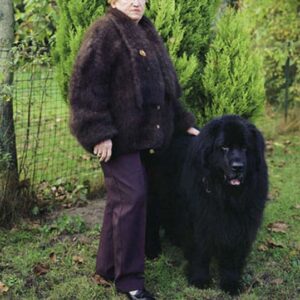
In fact, the hair has some advantages over wool. Sheep wool stretches and shrinks, while dog hair does not. And it can be up to eight times warmer because the strand has a hollow inner core that acts as insulation. Additionally, the dog-knitted items have a halo, a soft fuzz that outlines the item, identical to that of Angora rabbit fur.
As far as maintenance of the garment is concerned, you treat it the same as you would a wool one.
HISTORY OF DOG HAIR YARN
The idea is not so crazy. In fact, studies show that some indigenous people in the Pacific Northwest bred special dogs to make blankets thousands of years before Europeans arrived on the continent. Other cultures in cold climates did the same.
HARVESTING AND PROCESSING DOG HAIR YARN
The bad news is that you shouldn’t use clipped hair for making yarn. Fibers removed through brushing or vacuuming the floor are preferred and the longer follicles make stronger yarn. Moreover, the hair from the underbelly is ideal.
The good news is that a brown paper grocery bag full of hair will most likely yield a scarf, about six ounces.
Now you’re ready to make the yarn. It’s simple. Only 15 easy steps. Yikes!
If you’re too lazy to make your own yarn (I certainly fall into this category), never fear. Companies exist to do the work for you!
IF YOU’RE NOT INTO DOG HAIR YARN, TRY THIS
If you’re not inclined to make yarn, there are other things you can do with the hair rather than dumping it in the landfill.
Deter pests. Turns out garden terrorists such as gophers, squirrels, rabbits, and chipmunks fear dogs so spreading the hair in the garden keeps them away.
Clean up oil spills. Really? You betcha. Just send the furballs to Matter of Trust and they will use it to draw oil pollution out of water. (You can also send hair, wool, and fleece to them.)
Stuff toys or pillows. OK. I know this sounds a bit creepy but remember horsehair has traditionally been used for stuffing anything from mattresses to upholstered furniture. Just be sure to wash it with dog shampoo prior to use.
Make felt. Really? I’d much rather buy it at the store…. Still I’m trying to be nice to the environment. According to The Wildest Website:
Making felt out of pet hair — or any fiber — is super easy. All you need are two containers, dish soap, and, of course, a bunch of fur. Fill a container with warm water and some dish soap and fill another with cold water. Then simply bunch some fur into a ball, dip the ball into the soapy water, squeeze out the excess water, and rub the fur between your fingers (or into a ball between your palms, if you prefer a round shape). Once it’s felted, dip it into the cold water to rinse. When you’re done, you can use essential oils to add scent to the felt or Kool-Aid to dye it.
Compost. Spread the hair thinly in your compost pile. With airing it should break down in about a month.
Give it to birds. The stuff is great for nests. Wrap tufts around branches, fence posts, or leave a mesh bag of the fuzz somewhere accessible.
THOUGHTS ABOUT DOG HAIR YARN
Some may be squeamish about wearing something from a beloved pet. However, it strikes me as comforting. How nice it would be to have something more relatable to remind me of my dearly departed Australian Shepard, Pepper, than a box of ashes and a picture of her with Santa Claus. How I’d love to cuddle up to that sweet darling’s fur once again.
Sign up on www.mariewatts.com to receive future Stories About Life delivered to your email address or read more stories by clicking here.

Recent Comments